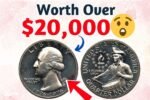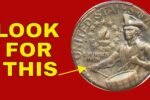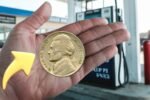War-Era Jefferson Nickel: In the world of numismatics, there are few coins that hold as much historical significance and collector allure as the 1943-P Jefferson Nickel. Born out of the urgent needs of World War II, this humble five-cent coin has transformed from wartime currency to prized collectible, with some rare specimens now selling for five-figure prices at auction.
A Coin Shaped by History
The story of the 1943-P nickel begins with America’s wartime mobilization. When nickel became essential for armor plating and munitions, the U.S. Mint made an unprecedented change – replacing the traditional 75% copper/25% nickel composition with a silver alloy (35% silver, 56% copper, 9% manganese). This emergency measure created what collectors now call the “Silver War Nickel,” distinguished by their large “P” mint mark above Monticello – the first time Philadelphia-mint coins bore a mint mark.
The Rarity That Drives Value
While millions were struck, one particular variety stands out: the 1943-P 3-over-2 overdate error. This occurred when a 1943 die was impressed over a 1942 die, creating visible doubling of the date. Combined with the “Full Steps” designation (indicating crisp details on Monticello’s staircase), these error coins represent the holy grail for Jefferson nickel collectors. In top condition, they’ve sold for over $10,000, with values steadily appreciating as more collectors enter the market.
More Than Silver Content
While the coin’s 0.056 ounces of silver give it intrinsic value, collectors prize it for deeper reasons:
- Historical significance as a homefront artifact
- Distinctive appearance with bold mint marks
- Connection to America’s industrial adaptation during crisis
- Accessibility compared to rarer gold coins
A Collector’s Accessible Treasure
What makes the 1943-P nickel particularly appealing is its democratic nature. Unlike many rare coins locked away in museums or elite collections, these still surface in everyday life – found in estate sales, inherited collections, or even (rarely) in circulation. This accessibility fuels collector enthusiasm, with many numismatists reporting increased interest from new collectors drawn to its tangible connection to WWII history.
Why This Coin Still Matters
Beyond its monetary value, the 1943-P nickel serves as a pocket-sized lesson in American resilience. It represents how ordinary objects were transformed by extraordinary circumstances, and how necessity bred innovation. For collectors, each specimen tells multiple stories – of mint workers adapting to wartime demands, of citizens using unfamiliar-looking coins, and of numismatists preserving these metallic time capsules for future generations.
As this wartime nickel continues its journey from pocket change to collector’s showcase, it reminds us that value isn’t always measured in precious metals alone. Sometimes, the most meaningful treasures are those that carry history in their alloy and stories in their strike marks – waiting to be rediscovered and appreciated anew.
FAQs: How a War-Era Jefferson Nickel Became One of America’s Most Valuable Coins
Q1: What is the War-Era Jefferson Nickel?
A: The War-Era Jefferson Nickel refers to nickels minted from 1942 to 1945 during World War II. These coins are distinct because they contain 35% silver due to a wartime metal shortage.
Q2: Why did the U.S. Mint change the composition of the nickel during WWII?
A: During WWII, nickel was a critical material for military equipment. To conserve this resource, the Mint replaced the usual 75% copper/25% nickel alloy with a mix of 56% copper, 35% silver, and 9% manganese.
Q3: How can you identify a War-Era Jefferson Nickel?
A: These nickels have a large mint mark (P, D, or S) located above Monticello on the reverse side. The “P” mark for Philadelphia was used for the first time in U.S. coinage history.



